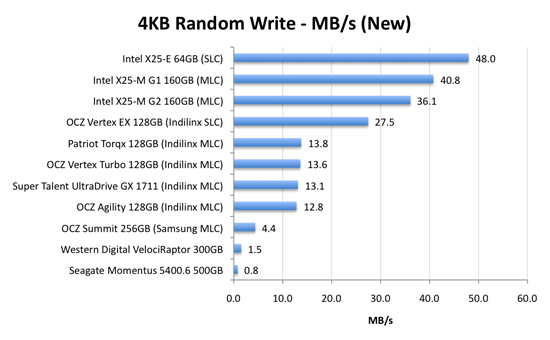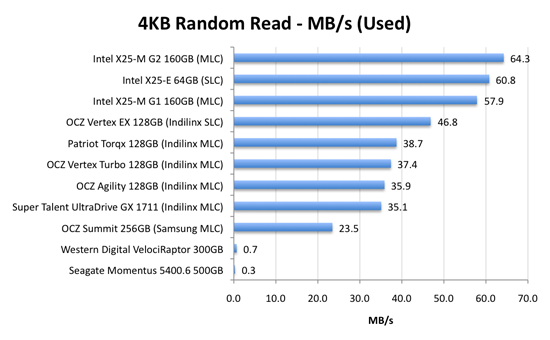The SSD Relapse: Understanding and Choosing the Best SSD
by Anand Lal Shimpi on August 30, 2009 12:00 AM EST- Posted in
- Storage
Random Read/Write Speed
This test writes 4KB in a completely random pattern over an 8GB space of the drive to simulate the sort of random writes that you'd see on an OS drive (even this is more stressful than a normal desktop user would see). I perform three concurrent IOs and run the test for 3 minutes. The results reported are in average MB/s over the entire time:

As we established in previous articles, the disk operations that feel the slowest are the random small file reads and writes. Both of which are easily handled by an SSD. A good friend of mine and former AnandTech Editor, Matthew Witheiler, asked me if he'd notice the performance improvement. I showed him the chart above.
He asked again if he'd notice. I said, emphatically, yes.

Now this is super interesting. Intel's X25-M G1 drops from 40.8MB/s when new down to 26.3MB/s in a well used state. Unfortunately for the G1, it will never get TRIM and will spend more time in the lower performance state over the life of the drive. But look at what happens with the X25-M G2: it drops from 36.1MB/s to 35.8MB/s - virtually no performance is lost. In fact, the G2 is so fast here that it outperforms the super expensive X25-E. Granted you don't get the lifespan of the X25-E and the SLC drive should perform better on more strenuous random write tests, but this is a major improvement.
The explanation? It actually boils down to the amount of memory on the drive. The X25-M G1 had 16MB of 166MHz SDRAM on-board, the G2 upped it to 32MB of slower 133MHz DRAM. Remember that Intel doesn't keep any user data in DRAM, it's only used for the remapping, defragmenting and tracking of all of the data being written to the drive. More DRAM means that the drive can now track more data, which means that even in the heaviest of random-write workloads you could toss at it on a normal desktop you will not actually lose any performance with the drive in a used state. And this is the drive Intel has decided to grant TRIM to.
The G2 is good.
The Indilinx drives do lose performance here. They drop from roughly 13MB/s down to 7MB/s. We're still talking ~5x the speed of a VelociRaptor, so there's no cause for alarm. But it's clear that even Indilinx's SLC drive can't match Intel's random write performance. And from what I hear, Intel's performance is only going to get better.
This is what the X25-M price premium gets you.

Bahahaha, look at the hard drive scores here: 0.7MB/s and 0.3MB/s? That's freakin' terrible! And that's why your system feels so slow when you start it up, there are a ton of concurrent random reads and writes happening all over the place which your hard drive crunches through at roughly 0.5MB/s. Even the Samsung based OCZ Summit manages a significant performance advantage here.
The Indilinx drives all cluster around the 30 - 40MB/s mark for random read performance, nothing to be ashamed of. The Intel drives kick it up a notch and give you roughly 60MB/s of random read performance. It's a noticeable improvement. As our application launch tests will show however, loading a single app on either an Indilinx or Intel drive will take about the same amount of time. It's only in the heavy multitasking and "seat of the pants" feel that you'll have a chance at feeling a difference.










295 Comments
View All Comments
kisjoink - Monday, August 31, 2009 - link
"Intel doesn't need to touch the G1, the only thing faster than it is the G2."I've been an avid anandtech-reader since 1998, but this is the first time I'm commenting on an article. I just have to say how much I disagree with this quote!
I've used the x25m since its launch (December 08) and at first I was very happy with the drive. Although really expensive, I got convinced to buy one after reading your first previews and review. And the performance was great, at least for the first 4-5 months. At that time I started noticing some 'hiccups' (system freeze). At first they were few and short. But over time they become more noticeable and now they're a real pain. Sometimes my system can freeze for more than 15 seconds. It usually happens when I edit a picture in photoshop, but it can also happen while writing something in Word, programming java in Eclipse or just surfing the web.
The problem? I'm pretty sure its the Intel drive. After reading too many SSD-articles I immediately suspected the x25m when the I started noticing the hiccups. So I got used to running the "Windows Resource Monitor" in the background - studying the disk activity after every hiccup. Just take a look at this example (just started photoshop and did some light editing on a picture):
http://img256.imageshack.us/img256/3073/hickup.jpg">http://img256.imageshack.us/img256/3073/hickup.jpg
I'm sure there are many ways I could tune my system better. I've done a couple of things, like moved the internet temp folder to a mechanical drive etc. And the performance of the drive will probably recover if I do this special SSD-format - but it's a real pain to have to do complete OS installation 2-3 times a year when you claim it's possible for Intel to create a new firmware with TRIM-support. I mean - I really did pay premium price for this product (close to 800$ included VAT here in Norway for the 80GB version in December 08).
So, to summarise - I got convinced to buy the drive after reading your articles (you write great reviews!) - and I understand that the problem that I (and others from what I've been reading on forums) is really difficult to recreate in a testing environment - but that doesn't mean that the problem doesn't exist. I just wish you could point this out. The expensive G1 has some really big performance issues that might force you to do a complete reinstall of your system a couple times a year - and although Intel could fix it they wont, because they have a new, better and cheaper product out - and people like me (altough we feel really screwed over by Intel) will buy their next device (as long as its the best device out there).
IntelUser2000 - Monday, August 31, 2009 - link
Is that after you installed the firmware version 8820 or before?? That reduces the problem a lot unless you filled the drive to more than 70%.kisjoink - Monday, August 31, 2009 - link
Yes, I forgot to mention that - it's after I upgraded to the 8820 firmware. I don't think I've ever filled it up with more than 80%, usually I have about 30GB of free spaceAnand Lal Shimpi - Monday, August 31, 2009 - link
This is actually an interesting scenario that I've been investigating a bit myself. The 8820 firmware actually significantly changes the way the drive likes to store data compared to the original firmware. That's fine for a cleanly secure-erased drive, but what happens if you have data/fragmentation on the drive already?Every time you write to the drive the controller will look at the preferred state specified by the new firmware. It will see that your data is organized the way the old firmware liked it, but not the new firmware. Thus upon every...single...write it will try and reorganize the data until it gets to its happy state.
I honestly have no idea how long this process will take, I can see it taking quite a bit of time but perhaps you could speed it up by writing a bunch of sequential files to fill up the drive? The safer bet would be to backup, secure erase and restore onto the drive. You shouldn't see it happen again.
Think of it like this. I live in my house and I have everything organized a certain way. It takes me minimal time to find everything I need. Let's say tomorrow I leave my house and you move in. You look at how things are organized and it's quite different from how you like things setup. Whenever you go to grab a plate or book you try cleaning up a bit. Naturally it'll take a while before things get cleaned up and until then you won't be as quick as you're used to.
Take care,
Anand
jimhsu - Friday, September 11, 2009 - link
The G2's I've discovered REALLY don't like to be filled up more than 80% or so. When I had 8GB free on the 80GB drive, seq write performance basically plummeted at random intervals (to levels like 30MB/s.) Random writes sometimes dropped down to 4MB/s. Now that I've freed 20GB and tried writing and deleting large ISO files to the drive, the performance is coming back slowly.Dunk - Monday, August 31, 2009 - link
Hi Anand,I'm blown away by your article series on SSD - absolutely fantastic.
When new Intel firmware is launched with TRIM support for the G2, can I flash it without losing the drive and needing to reinstall everything?
I'm happy using the out of the box MS driver for now in Win7, but would prefer to use Intel's TRIM version once available.
Many thanks
Duncan
Anand Lal Shimpi - Monday, August 31, 2009 - link
If Intel follows the same pattern as what we saw with the G1's firmware update, you should be able to flash without destroying your data (although it's always a good idea to back up).Thank you for your comment :)
Take care,
Anand
mgrmgr - Monday, August 31, 2009 - link
Okay, single X25-M G2s can be updated without losing data. But I am considering two 80GB drives in RAID-0 to overcome the sequential write slowdown with Photoshop. How will updating work for the RAID-0 pair?Do you have an opinion about using a RAID pair for Photoshop?
Noteleet - Monday, August 31, 2009 - link
Fantastic article, I'm definitely planning on getting a SSD next time I upgrade.I'm fairly interested in seeing some reviews for the Solid 2. If OCZ can get the kinks worked out I think the Intel flash and the Indilinx controller would make a winning combination for price to performance.
Visual - Monday, August 31, 2009 - link
Where does the drive store the mapping between logical and physical pages and other system data it needs to operate? Does it use the same memory where user data is stored? If so, doesn't it need to write-balance that map data as well? And if that's true, doesn't it need to have a map for the map written somewhere? How is that circular logic broken?Or does the drive have some small amount of higher-quality, more reliable, maybe single-level-cell based flash memory for its system data?